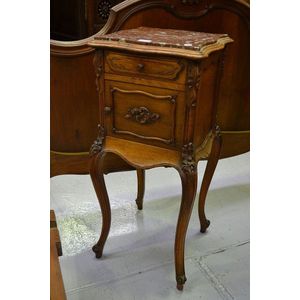French Cherrywood Bureau Plat, c.1780-1800
A fine cherrywood French provincial bureau plat, c.1780- 1800, Normandy origin, mitre-cleated top above a generous central kneehole, flanked by a pair of deep drawers, each carved with raised and scrolled mouldings. The opposite side and ends, panelled above wave cut aprons with raised scrolled mouldings. Standing on four cabriole legs with raised edge mouldings and terminating in scrolled, hoof feet. Concealed pull-out extensions on each side.(each 500 mm) original, ornate, brass keyholes. Key included. fruitwood of pale colour, good mellow surface patination.. provenance: Lee Harper Antiques c.1989, 74 x 164 x 74 cm
You must be a subscriber, and be logged in to view price and dealer details.
Subscribe Now to view actual auction price for this item
When you subscribe, you have the option of setting the currency in which to display prices to $Au, $US, $NZ or Stg.
This item has been sold, and the description, image and price are for reference purposes only.
- Provenance - A term used to describe the provable history of an antique or work of art, and thus an additional aid to verifying its authenticity. Provenance can have an inflating effect on the price of an item, particularly if the provenance relates to the early settlement of Australia, a famous person, or royalty. Less significant are previous sales of the item through an auction house or dealer.
- Hoof Foot - A hoof foot, resembling an animal's hoof was sometimes used at the termination of a cabriole leg.
- Cabriole Leg - The cabriole leg evolved from an elongated scroll, curving out at the knee which may or may not be carved, and forming a serpentine shape as it descends to the foot.
First introduced into English furniture in the late 17th century, cabriole legs were widely used during the Queen Anne and early Georgian periods, where they frequently terminated in a pad foot or ball and claw foot. The style has had many imitators since then. The cabriole leg was re-introduced in the mid-19th century, and is commonly associated with the balloon-back dining or drawing-room chairs made in walnut, mahogany or, in Australia, cedar. The Victorian cabriole leg, on the whole, was rather more slender than the earlier form, following the French style, which emphasized the delicacy and daintiness of the chairs they were designed to support. Cabriole legs are sometimes found on windsor chairs, especially those made during the 18th century. - Patination / Patina - In broad terms, patination refers to the exterior surface appearance of the timber, the effect of fading caused by exposure to sunlight and air over the course of a century or more, changing the piece to a soft, mellow colour.
As patina is very difficult to replicate, it is one of the most important guides to determining the age of furniture.
Patina is also the term applied to the bloom or film found on old bronzes due to oxidisation. - Kneehole - A recessed section, mainly found on Georgian desks and dressing tables, which does not go through the full depth of the item, and usually terminates in a cupboard at the back.
- Fruitwood - A catch-all term used to describe the wood of any of several fruit-bearing trees, such as the apple, cherry, or pear, used especially in cabinetmaking.
With a blond colour when finished, fruitwood was used in Europe, especially France, in the 18th and 19th centuries for larger items of furniture such as tables, chairs, cabinets and bookcases but in England its use was generally restricted to decorative elements such as inlays. - Mouldings - Decorative strips, deriving from architectural features, that may be either applied separately to a piece of furniture or worked directly on to the carcase. Mouldings are found on cornices or pediments, around the edges of panels and drawer fronts, and around both the tops and bottoms of chests, bookcases and other cabinet furniture. Until the late 19th century mouldings were worked by hand, using a shaped moulding plane. Latterly, they have been shaped by machine.
Visually similar items

Vintage French Louis XV style floral parquetry nightstand, approx 75 cm high
Sold by
in
for
You can display prices in $Au, $US, $NZ or Stg.

French Louis XV style marble topped nightstand. Height 85 cm
Sold by
in
for
You can display prices in $Au, $US, $NZ or Stg.

A Superior inlaid mahogany dining room suite, comprising two leaf extension table, eight rattan back chairs and a four door four drawer sideboard, 260 x 107 x 75 cm (table, Extended) / 215 x 50 x 93 cm (sideboard)
Sold by
in
for
You can display prices in $Au, $US, $NZ or Stg.

Antique French Louis XV style nightstand
Sold by
in
for
You can display prices in $Au, $US, $NZ or Stg.
